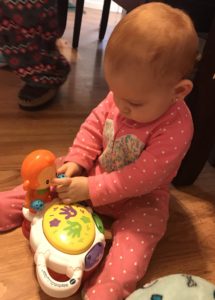 We call this bilateral integration and it is a really important skill for independence. Almost everything we do requires the use of our two hands working together, but it takes some coordination for your baby to master this skill.
We call this bilateral integration and it is a really important skill for independence. Almost everything we do requires the use of our two hands working together, but it takes some coordination for your baby to master this skill.
Both sides of the brain are active, as well as vision skills, eye-hand coordination, and dexterity. You may begin to notice that your baby tends to use one hand as the stabilizer and the other hand to do the motion or activity. For example, she might tend to always hold the bottle with her left hand and attempt to remove and replace the lid with her right hand. This can give us an early clue into handedness. Babies who tend to do most of the action with one hand over the other usually end up being dominant in that hand. Usually before 18 months, babies are using both hands the same and this is what we like to see.
Some toys and activities that encourage use of both hands together are:
- pop beads
- large leggos
- lacing cards
- stringing large beads
- opening Easter eggs
- Velcro blocks
- musical instruments such as cymbals
- catching and throwing a ball
- wind up toys
- stacking cups

